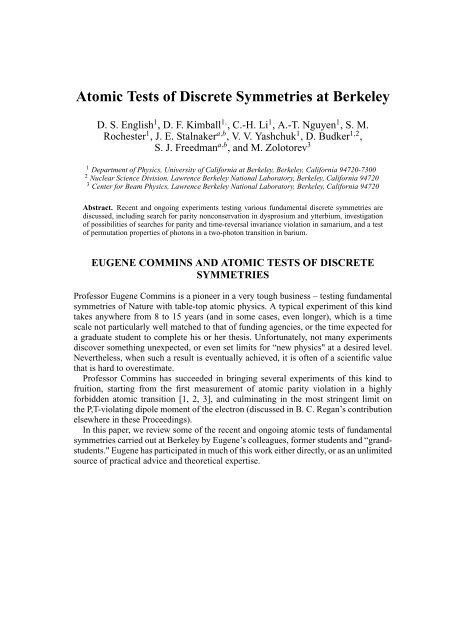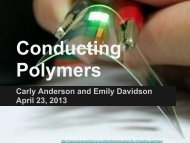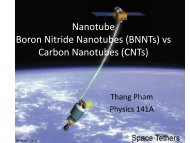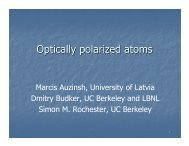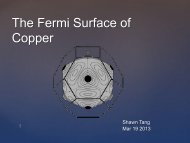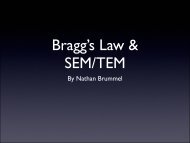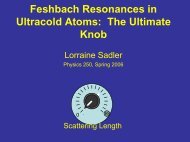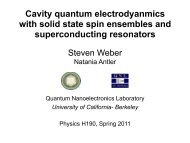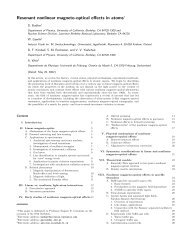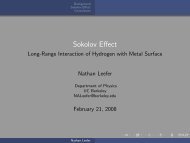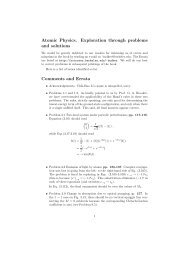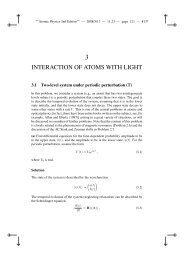Atomic Tests of Discrete Symmetries at Berkeley - The Budker Group
Atomic Tests of Discrete Symmetries at Berkeley - The Budker Group
Atomic Tests of Discrete Symmetries at Berkeley - The Budker Group
Create successful ePaper yourself
Turn your PDF publications into a flip-book with our unique Google optimized e-Paper software.
<strong>Atomic</strong> <strong>Tests</strong> <strong>of</strong> <strong>Discrete</strong> <strong>Symmetries</strong> <strong>at</strong> <strong>Berkeley</strong><br />
D. S. English 1 , D. F. Kimball 1, , C.-H. Li 1 , A.-T. Nguyen 1 , S. M.<br />
Rochester 1 , J. E. Stalnaker a,b , V. V. Yashchuk 1 , D. <strong>Budker</strong> 1,2 ,<br />
S. J. Freedman a,b , and M. Zolotorev 3<br />
1 Department <strong>of</strong> Physics, University <strong>of</strong> California <strong>at</strong> <strong>Berkeley</strong>, <strong>Berkeley</strong>, California 94720-7300<br />
2 Nuclear Science Division, Lawrence <strong>Berkeley</strong> N<strong>at</strong>ional Labor<strong>at</strong>ory, <strong>Berkeley</strong>, California 94720<br />
3 Center for Beam Physics, Lawrence <strong>Berkeley</strong> N<strong>at</strong>ional Labor<strong>at</strong>ory, <strong>Berkeley</strong>, California 94720<br />
Abstract. Recent and ongoing experiments testing various fundamental discrete symmetries are<br />
discussed, including search for parity nonconserv<strong>at</strong>ion in dysprosium and ytterbium, investig<strong>at</strong>ion<br />
<strong>of</strong> possibilities <strong>of</strong> searches for parity and time-reversal invariance viol<strong>at</strong>ion in samarium, and a test<br />
<strong>of</strong> permut<strong>at</strong>ion properties <strong>of</strong> photons in a two-photon transition in barium.<br />
EUGENE COMMINS AND ATOMIC TESTS OF DISCRETE<br />
SYMMETRIES<br />
Pr<strong>of</strong>essor Eugene Commins is a pioneer in a very tough business – testing fundamental<br />
symmetries <strong>of</strong> N<strong>at</strong>ure with table-top <strong>at</strong>omic physics. A typical experiment <strong>of</strong> this kind<br />
takes anywhere from 8 to 15 years (and in some cases, even longer), which is a time<br />
scale not particularly well m<strong>at</strong>ched to th<strong>at</strong> <strong>of</strong> funding agencies, or the time expected for<br />
a gradu<strong>at</strong>e student to complete his or her thesis. Unfortun<strong>at</strong>ely, not many experiments<br />
discover something unexpected, or even set limits for “new physics" <strong>at</strong> a desired level.<br />
Nevertheless, when such a result is eventually achieved, it is <strong>of</strong>ten <strong>of</strong> a scientific value<br />
th<strong>at</strong> is hard to overestim<strong>at</strong>e.<br />
Pr<strong>of</strong>essor Commins has succeeded in bringing several experiments <strong>of</strong> this kind to<br />
fruition, starting from the first measurement <strong>of</strong> <strong>at</strong>omic parity viol<strong>at</strong>ion in a highly<br />
forbidden <strong>at</strong>omic transition [1, 2, 3], and culmin<strong>at</strong>ing in the most stringent limit on<br />
the P,T-viol<strong>at</strong>ing dipole moment <strong>of</strong> the electron (discussed in B. C. Regan’s contribution<br />
elsewhere in these Proceedings).<br />
In this paper, we review some <strong>of</strong> the recent and ongoing <strong>at</strong>omic tests <strong>of</strong> fundamental<br />
symmetries carried out <strong>at</strong> <strong>Berkeley</strong> by Eugene’s colleagues, former students and “grandstudents."<br />
Eugene has particip<strong>at</strong>ed in much <strong>of</strong> this work either directly, or as an unlimited<br />
source <strong>of</strong> practical advice and theoretical expertise.
P- AND P,T-VIOLATION IN HEAVY ATOMS WITH CLOSELY<br />
SPACED OPPOSITE PARITY LEVELS<br />
P- and P,T-viol<strong>at</strong>ing interactions mix <strong>at</strong>omic levels <strong>of</strong> opposite parity. According to<br />
perturb<strong>at</strong>ion theory, the mixing is proportional to the m<strong>at</strong>rix element <strong>of</strong> the symmetryviol<strong>at</strong>ing<br />
interaction, and inversely proportional to the difference in the energies <strong>of</strong> the<br />
two st<strong>at</strong>es (the energy denomin<strong>at</strong>or). This suggests an enhancement mechanism – the use<br />
<strong>of</strong> opposite-parity st<strong>at</strong>es th<strong>at</strong> are nearly degener<strong>at</strong>e. Thus, many experimental <strong>at</strong>tempts<br />
and proposals <strong>of</strong> <strong>at</strong>omic symmetry tests have concentr<strong>at</strong>ed on hydrogen (e.g. [4] and<br />
references therein) and hydrogenic ions (e.g. [5] and references therein).<br />
Another enhancement, first pointed out by P. G. H. Sandars for P,T-odd interactions<br />
back in 1960’s, and by M.-A. Bouchi<strong>at</strong> and C. Bouchi<strong>at</strong> for P-odd interactions in the<br />
1970’s, is present in heavy <strong>at</strong>oms. In fact, for neutral <strong>at</strong>oms, both the <strong>at</strong>omic electricdipole<br />
moment (EDM) due to an EDM <strong>of</strong> the electron, and the dominant (nuclear-spinindependent)<br />
part <strong>of</strong> the parity-nonconserving (PNC) interaction scale approxim<strong>at</strong>ely<br />
like Z 3 , where Z is the <strong>at</strong>omic number.<br />
Since mid-1980’s [6, 7] there has been considerable interest in studying P- and P,Todd<br />
effects in the rare-earth <strong>at</strong>oms, which seemed to have <strong>of</strong>fered the best <strong>of</strong> both<br />
worlds – large Z ∼ 60 − 70, and many cases <strong>of</strong> small spacing between opposite-parity<br />
st<strong>at</strong>es. Eugene Commins became interested in experimental work th<strong>at</strong> was carried with<br />
samarium <strong>at</strong> Novosibirsk [8] during his visit to Siberia in the Summer <strong>of</strong> 1987, where he<br />
<strong>at</strong>tended the Vavilov conference [3]. This is how this research eventually got transplanted<br />
from Novosibirsk to <strong>Berkeley</strong>.<br />
PARITY NONCONSERVATION IN DYSPROSIUM<br />
<strong>The</strong> idea <strong>of</strong> an enhancement due to closely spaced, opposite-parity levels is most compelling<br />
in the case <strong>of</strong> dysprosium (Dy; Z = 66). Here there are two levels whose energy<br />
separ<strong>at</strong>ion is on the order <strong>of</strong> hyperfine-structure splittings and isotope shifts. <strong>The</strong>se two<br />
st<strong>at</strong>es <strong>of</strong> even and odd parity (and design<strong>at</strong>ed as A and B, respectively) both have J= 10<br />
and lie 19797.96 cm −1 above the J= 8 ground st<strong>at</strong>e (Fig. 1). Spectroscopic properties <strong>of</strong><br />
Dy, and particularly <strong>of</strong> these st<strong>at</strong>es were studied in Refs. [9, 10, 11], including lifetimes<br />
which were found to be 7.9 µs for A and > 200 µs for B.<br />
<strong>The</strong> smallness <strong>of</strong> the level separ<strong>at</strong>ion grants one the opportunity (as well as dict<strong>at</strong>es<br />
the necessity) <strong>of</strong> performing an entirely different kind <strong>of</strong> PNC measurement as compared<br />
to the traditional optical-rot<strong>at</strong>ion and PNC-Stark-interference-induced-dichroism<br />
PNC experiments. We apply a rel<strong>at</strong>ively weak magnetic field (∼ 1.4 Gs), which brings<br />
energy separ<strong>at</strong>ion between certain Zeeman sublevels <strong>of</strong> A and B close to zero, and observe<br />
quantum be<strong>at</strong>s due to the presence <strong>of</strong> an external electric field <strong>of</strong> a few V/cm.<br />
Because the PNC effect is T-even, the electric field has to be time varying (for co-linear<br />
electric and magnetic fields) in order for there to be Stark-PNC interference [12]. For an<br />
oscill<strong>at</strong>ing electric field, the interference term in transition probability contributes <strong>at</strong> the<br />
same frequency as the the electric-field frequency (whereas the dominant signal due to<br />
the Stark-induced mixing oscill<strong>at</strong>es <strong>at</strong> twice the frequency). Another PNC sign<strong>at</strong>ure is
FIGURE 1. Partial level diagram <strong>of</strong> Dy showing the transitions in the current popul<strong>at</strong>ion scheme. Solid<br />
arrows indic<strong>at</strong>e excit<strong>at</strong>ion; dashed arrows indic<strong>at</strong>e spontaneous decay.<br />
th<strong>at</strong> it reverses with the sign <strong>of</strong> the residual energy separ<strong>at</strong>ion (decrossing) as described<br />
by the P-odd, T-even rot<strong>at</strong>ional invariant:<br />
dE<br />
dt · (B − B c), (1)<br />
where B c is the magnetic field required to cross the levels.<br />
Our most recent PNC search [12] was originally motiv<strong>at</strong>ed by theoretical estim<strong>at</strong>es<br />
[13] predicting a substantial enhancement due to the small energy separ<strong>at</strong>ion <strong>of</strong> the<br />
opposite-parity levels. <strong>The</strong>se estim<strong>at</strong>es had large uncertainties due to extreme complexity<br />
<strong>of</strong> the structure <strong>of</strong> the <strong>at</strong>omic st<strong>at</strong>es involved. Unfortun<strong>at</strong>ely, despite the fact th<strong>at</strong><br />
the experimental sensitivity to the PNC m<strong>at</strong>rix element (H w ) considerably exceeds other<br />
PNC experiments performed so far (see, e.g., Ref. [14] for a review), no PNC effect was<br />
detected, and an upper limit <strong>of</strong> |H w | < 5 Hz (68% C.L.) was established. This st<strong>at</strong>isticslimited<br />
experiment used pulsed lasers with repetition r<strong>at</strong>e <strong>of</strong> 10 Hz, which led to a low<br />
effective duty cycle (∼ 10 −4 ). Using cw lasers, we have developed an efficient popul<strong>at</strong>ion<br />
method <strong>of</strong> the nearly degener<strong>at</strong>e st<strong>at</strong>es [15] which will significantly improve the<br />
sensitivity <strong>of</strong> the PNC measurement (see below).<br />
<strong>The</strong> basic setup for the current PNC measurement is depicted in Fig. 2. Atoms<br />
emerge from an effusive oven source oper<strong>at</strong>ing <strong>at</strong> T ∼ 1500 K and pass through several<br />
collim<strong>at</strong>ors. <strong>The</strong>n, they enter the electric- and magnetic-field interaction region where<br />
they are excited by laser beams and end up popul<strong>at</strong>ing the odd-parity st<strong>at</strong>e B (the role <strong>of</strong><br />
the cylindrical lenses will be described below). A sinusoidally varying electric field is<br />
applied with two grids consisting <strong>of</strong> ∼ 5 × 10 −3 cm diam. Be-Cu wire. Wire grids were<br />
chosen instead <strong>of</strong> pl<strong>at</strong>es in order to minimize stray surface charge. <strong>The</strong> magnetic field
FIGURE 2. Current Dy PNC setup: a) <strong>at</strong>omic beam produced by effusive oven source <strong>at</strong> T= 1500 K; b)<br />
<strong>at</strong>omic beam collim<strong>at</strong>ors; c) interaction region <strong>of</strong> <strong>at</strong>oms with E-field (∼ 4 V/cm) produced between wire<br />
grids and B-field (∼ 1.4 Gs) produced by wire turns; mu-metal yoke provides high homogeneity; entire<br />
region is enclosed in a magnetic shield (not shown); d) cylindrical lens to diverge laser beams; e) mirror;<br />
f) light pipe; and g) interference filter.<br />
is produced by wires forming a rectangular solenoid whose magnetic flux is “shorted"<br />
by a CO-NETIC yoke. <strong>The</strong> mirror currents due to the yoke add to the field produced<br />
by the coil, and the entire configur<strong>at</strong>ion leads to a r<strong>at</strong>her homogeneous magnetic field<br />
in the interaction region similar to th<strong>at</strong> <strong>of</strong> an infinitely long solenoid. <strong>The</strong> electric- and<br />
magnetic-field homogeneity is ∼ 10 −3 within the volume <strong>of</strong> ∼ 100 cm 3 where <strong>at</strong>oms<br />
interact with the laser beams, experience quantum be<strong>at</strong>s and fluoresce. <strong>The</strong> interaction<br />
region is enclosed by a single layer <strong>of</strong> magnetic shielding (not shown). Fluorescence is<br />
directed by a light pipe onto a photomultiplier tube.<br />
In the current popul<strong>at</strong>ion scheme, three transitions are required to reach the longerlived,<br />
odd-parity st<strong>at</strong>e B (Fig. 1). <strong>The</strong> <strong>at</strong>oms are first excited by 833-nm and then by<br />
669-nm light. <strong>The</strong> final step involves spontaneous decay <strong>at</strong> 1397 nm, with a measured<br />
branching r<strong>at</strong>io <strong>of</strong> 0.30(9) [16]. In order to popul<strong>at</strong>e a large fraction <strong>of</strong> the weakly collim<strong>at</strong>ed<br />
<strong>at</strong>omic beam, the laser frequency is effectively broadened by using a cylindrical<br />
lens to diverge the laser beam. For sufficiently large light intensities, this leads to an efficient<br />
and robust popul<strong>at</strong>ion inversion analogous to adiab<strong>at</strong>ic passage used in magnetic<br />
resonance [17]: as the <strong>at</strong>oms pass through the beam, they experience a sweep in light<br />
frequency due to the Doppler effect th<strong>at</strong> is slow compared to Rabi oscill<strong>at</strong>ions. In our<br />
case, the adiab<strong>at</strong>ic criterion requires th<strong>at</strong> the Rabi frequency be much larger than the<br />
transverse Doppler width [15].<br />
With this scheme, we have achieved popul<strong>at</strong>ion transfer over a large fraction <strong>of</strong> the<br />
transverse-<strong>at</strong>omic-velocity distribution. For the 833-nm transition, a substantial portion<br />
<strong>of</strong> the transverse-velocity distribution underwent adiab<strong>at</strong>ic passage. Although the second<br />
transition <strong>at</strong> 669 nm did not exhibit adiab<strong>at</strong>ic passage, the transfer efficiency into st<strong>at</strong>e B<br />
is nevertheless large due the short lifetime <strong>of</strong> st<strong>at</strong>e f (Fig. 1) [15]. Further improvements<br />
are possible by increasing the power <strong>of</strong> the lasers used and by utilizing a laser <strong>at</strong> 1397 nm<br />
to stimul<strong>at</strong>e the f → B transition. <strong>The</strong> achieved popul<strong>at</strong>ion efficiency transl<strong>at</strong>es into
∼ 10 4 times higher counting r<strong>at</strong>e compared to the pulsed PNC experiment[12]. With a<br />
similar technique and a total integr<strong>at</strong>ion time <strong>of</strong> 20 hours, this should allow us to reach<br />
a st<strong>at</strong>istical sensitivity to the weak m<strong>at</strong>rix element <strong>of</strong> ∼10 mHz.<br />
<strong>The</strong> future <strong>of</strong> dysprosium as a labor<strong>at</strong>ory for PNC studies depends crucially on the<br />
results <strong>of</strong> the current phase <strong>of</strong> the experiment. If the effect is “around the corner," (i.e.<br />
|H w | ∼ 1 Hz) Dy can still contribute to the study <strong>of</strong> both nuclear-spin-independent<br />
effects (via isotopic comparisons <strong>of</strong> the PNC effect), and to the study <strong>of</strong> the nuclearspin-dependent<br />
PNC (via comparison <strong>of</strong> the effect on different hyperfine transitions).<br />
If the effect is suppressed even more strongly, it appears th<strong>at</strong> Dy would not have<br />
sufficient advantages over other systems for PNC studies. However, the unique situ<strong>at</strong>ion<br />
in Dy could also be applied in other studies th<strong>at</strong> benefit from near-degeneracy <strong>of</strong> longlived<br />
opposite parity Zeeman sublevels, forming a well isol<strong>at</strong>ed two-level system with<br />
adjustable parameters (level spacing, projection <strong>of</strong> angular momenta <strong>of</strong> the crossing<br />
sublevels, their effective width, etc.).<br />
PARITY NONCONSERVATION IN YTTERBIUM<br />
Ytterbium (Yb; Z = 70) is another example <strong>of</strong> a unique system in which to study <strong>at</strong>omic<br />
PNC. Yb was first proposed as a system for studying PNC by one <strong>of</strong> Pr<strong>of</strong>essor Commins<br />
former gradu<strong>at</strong>e students, David DeMille [18], while he was <strong>at</strong> <strong>Berkeley</strong>.<br />
Like Dy, Yb is a rare-earth <strong>at</strong>om and has seven stable isotopes, including two isotopes<br />
with non-zero nuclear spin. However, because the ground st<strong>at</strong>e <strong>of</strong> Yb has a closed 4 f<br />
shell (in addition to a closed 6s shell), the low-lying energy levels more closely resemble<br />
those found in alkaline-earth <strong>at</strong>oms such as Ba and Ca. This makes the calcul<strong>at</strong>ions<br />
significantly more reliable than those done in other rare-earth <strong>at</strong>oms such as Dy and Sm.<br />
In Yb, the weak interaction mixes the even-parity 5d6s 3 D 1 st<strong>at</strong>e with the odd-parity<br />
6s6p 1 P 1 st<strong>at</strong>e (see Fig. 3). <strong>The</strong> mixing between these two st<strong>at</strong>es is expected to be<br />
large due to rel<strong>at</strong>ively small energy separ<strong>at</strong>ion between the two st<strong>at</strong>es (≈ 600cm −1 ) and<br />
favorable configur<strong>at</strong>ions among the st<strong>at</strong>es (the 1 P 1 st<strong>at</strong>e is not a pure 6s6p configur<strong>at</strong>ion<br />
and contains ≈ 15% 5d6p; allowing mixing between the 6s electron in the 3 D 1 st<strong>at</strong>e and<br />
the 6p electron in the 1 P 1 st<strong>at</strong>e).<br />
This mixing leads to a small electric-dipole (E1) transition amplitude between the<br />
6s 2 1 S 0 ground st<strong>at</strong>e and the 5d6s 3 D 1 st<strong>at</strong>e. <strong>The</strong> size <strong>of</strong> this PNC-induced transition<br />
amplitude was estim<strong>at</strong>ed in DeMille’s original proposal to be ≈ 10 −9 ea 0 (≈ 100 times<br />
larger than in Cs) [18]. This estim<strong>at</strong>e has been confirmed by more elabor<strong>at</strong>e calcul<strong>at</strong>ions<br />
<strong>of</strong> M.G. Kozlov, S. Porsev, and Yu. Rakhlina, [19] and B. P. Das [20].<br />
In addition to the large enhancement <strong>of</strong> the PNC effect, the transition also has a highly<br />
suppressed magnetic-dipole (M1) amplitude (≈ 10 −4 µ B [21]), and a moder<strong>at</strong>ely sized<br />
Stark-induced amplitude (2.18(33) × 10 −8 ea 0 /(V /cm) [21]) allowing the use <strong>of</strong> the<br />
Stark-interference technique in an <strong>at</strong>omic beam, which has been successfully employed<br />
for cesium [22].<br />
A schem<strong>at</strong>ic <strong>of</strong> the appar<strong>at</strong>us is shown in figure 4. A dc electric field mixes oppositeparity<br />
st<strong>at</strong>es and cre<strong>at</strong>es a Stark-induced E1 transition amplitude between the 1 S 0 and
FIGURE 3.<br />
Low-lying energy levels for Yb.<br />
3 D 1 st<strong>at</strong>es (see Fig. 3). This amplitude interferes with the PNC-induced E1 transition<br />
amplitude. A magnetic field is applied to separ<strong>at</strong>e the magnetic sublevels <strong>of</strong> the upper<br />
st<strong>at</strong>e to prevent the cancell<strong>at</strong>ion <strong>of</strong> the interference terms for the different sublevels. <strong>The</strong><br />
<strong>at</strong>oms are excited using resonant laser light <strong>at</strong> 408 nm which is coupled into a powerbuild-up<br />
cavity. Changing the handedness <strong>of</strong> the geometry (reversing the electric field or<br />
the polariz<strong>at</strong>ion angle) changes the sign <strong>of</strong> the interference term, which is proportional<br />
to the P-odd rot<strong>at</strong>ional invariant<br />
(ε · B) ((ε × E) · B), (2)<br />
where ε is the light polariz<strong>at</strong>ion vector. This leads to a change in the number <strong>of</strong> <strong>at</strong>oms<br />
excited to the upper st<strong>at</strong>e. <strong>The</strong> excited <strong>at</strong>oms decay predominantly to the 3 P 1 and the<br />
metastable 3 P 0 st<strong>at</strong>es (≈ 35% and 64%, respectively) as indic<strong>at</strong>ed in figure 3. <strong>The</strong> <strong>at</strong>oms<br />
which decay to the 3 P 1 st<strong>at</strong>e can be detected through fluorescence from the subsequent<br />
decay to the ground st<strong>at</strong>e <strong>at</strong> 556 nm, while the <strong>at</strong>oms decaying to the metastable 3 P 0<br />
st<strong>at</strong>e can be probed downstream by exciting them to a higher-lying st<strong>at</strong>e and observing<br />
the subsequent fluorescence. Thus, it is possible to achieve high-efficiency detection <strong>of</strong><br />
the number <strong>of</strong> <strong>at</strong>oms undergoing the transition.<br />
<strong>The</strong> geometry described above was first employed by Pr<strong>of</strong>essor Commins in his PNC<br />
experiments in thallium (Tl) (see [2]; those experiments were done in a vapor cell r<strong>at</strong>her<br />
than an <strong>at</strong>omic beam). This geometry differs slightly from th<strong>at</strong> used in the Cs experiment<br />
[22]. Calcul<strong>at</strong>ions done by Pr<strong>of</strong>essor Commins in the early stages <strong>of</strong> the experiment
FIGURE 4.<br />
Experimental Appar<strong>at</strong>us for Yb PNC measurement.<br />
suggest th<strong>at</strong> this geometry is less sensitive to system<strong>at</strong>ic effects associ<strong>at</strong>ed with the<br />
nonzero M1 transition amplitude between the 6s 2 1 S 0 and 5d6s 3 D 1 st<strong>at</strong>es.<br />
During the past several years, we have pursued a detailed study <strong>of</strong> the spectroscopic<br />
parameters relevant to performing a PNC experiment in <strong>at</strong>omic Yb. <strong>The</strong>se preliminary<br />
investig<strong>at</strong>ions included measurements <strong>of</strong> the lifetimes <strong>of</strong> many relevant st<strong>at</strong>es, dc-<br />
Stark shifts, hyperfine and isotope shifts, and the Stark-induced amplitudes for both the<br />
6s 2 1 S 0 → 5d6s 3 D 1 transition and the 6s 2 1 S 0 → 5d6s 3 D 2 transition, another candid<strong>at</strong>e<br />
for a PNC experiment [23, 21]. Most recently we have completed a measurement <strong>of</strong> the<br />
highly forbidden M1 transition amplitude between the 6s 2 1 S 0 st<strong>at</strong>e and the 5d6s 3 D 1<br />
st<strong>at</strong>e using the Stark-interference technique [24]. All <strong>of</strong> these measurements have confirmed<br />
our understanding <strong>of</strong> the system and lead us to believe a high-precision test <strong>of</strong><br />
PNC in Yb using the Stark-interference technique in an <strong>at</strong>omic beam is feasible.<br />
One remaining question for the Stark-interference <strong>at</strong>omic beam experiment concerns<br />
the use <strong>of</strong> the power-build-up cavity in order to increase the number <strong>of</strong> <strong>at</strong>oms making<br />
the transition. <strong>The</strong> ac-Stark shifts resulting from the high-intensity standing wave inside<br />
the power-build-up cavity serve to broaden the <strong>at</strong>omic resonance. At high powers, some<br />
<strong>of</strong> the <strong>at</strong>oms are shifted out <strong>of</strong> resonance, decreasing the overall signal. Because the<br />
ac-Stark shift depends on the intensity <strong>of</strong> the light and the signal depends only on
its power, it is desirable to have a transverse-cavity-mode spot size which is as large<br />
as experimentally feasible. Unfortun<strong>at</strong>ely, as the cavity-mode size increases the cavity<br />
becomes more sensitive to misalignment and is less stable. Thus there is a practical<br />
limit on the size <strong>of</strong> a single cavity mode. Another approach th<strong>at</strong> we are pursuing is to<br />
use a confocal power-build-up cavity. In this case, each transverse mode is degener<strong>at</strong>e<br />
with either the fundamental transverse mode (with a different longitudinal index), or<br />
its eigenfrequency falls exactly between two fundamental modes [25]. Thus, instead <strong>of</strong><br />
coupling into just one transverse mode, it is possible to use a beam with a large spot size<br />
and excite many modes <strong>at</strong> once. <strong>The</strong> size <strong>of</strong> the ac-Stark shifts is the final quantity th<strong>at</strong><br />
must be measured before proceeding with the PNC experiment.<br />
In addition to the experiment described above we have investig<strong>at</strong>ed the possibility <strong>of</strong><br />
measuring the PNC effect in a vapor cell, which may allow for higher <strong>at</strong>omic densities<br />
and higher st<strong>at</strong>istical sensitivity [26, 27]. As with the <strong>at</strong>omic beam experiment the <strong>at</strong>oms<br />
would be excited in the presence <strong>of</strong> crossed electric and magnetic fields and a change<br />
in the transition r<strong>at</strong>e would be detected with a change in the handedness <strong>of</strong> the fields.<br />
<strong>The</strong> <strong>at</strong>oms undergoing the transition would be detected by using probe light <strong>at</strong> 649 nm<br />
resonant with a transition from the metastable 6s6p 3 P 0 st<strong>at</strong>e to a higher-lying 6s7s 3 S 1<br />
st<strong>at</strong>e. A possible limiting factor in this experiment is the collisional de-excit<strong>at</strong>ion <strong>of</strong><br />
the <strong>at</strong>oms in the metastable 6s6p 3 P 0 st<strong>at</strong>e by other Yb <strong>at</strong>oms as well as buffer gas<br />
<strong>at</strong>oms. We have measured the collisional perturb<strong>at</strong>ions <strong>of</strong> the 6s6p 3 P 0 st<strong>at</strong>e, including<br />
pressure broadening and de-excit<strong>at</strong>ion cross sections, due to quenching with possible<br />
buffer gases (He, Ne) and with Yb <strong>at</strong>oms [26]. <strong>The</strong>se experiments suggest th<strong>at</strong> indeed it<br />
may be possible to perform a Yb PNC experiment in a vapor cell with gre<strong>at</strong>er st<strong>at</strong>istical<br />
sensitivity than is possible with an <strong>at</strong>omic beam. However, there are many questions<br />
yet to be answered concerning the feasibility <strong>of</strong> such a measurement such as collisional<br />
broadening <strong>of</strong> the transition, ioniz<strong>at</strong>ion <strong>of</strong> the Yb <strong>at</strong>oms in the high-intensity light fields<br />
required for the experiment, and collisionally assisted transition r<strong>at</strong>es.<br />
Another possibility for a PNC experiment is an optical-rot<strong>at</strong>ion experiment in a vapor<br />
cell [28]. In this case the transition studied would be the M1 transition between the<br />
metastable 6s6p 3 P 0 st<strong>at</strong>e and the 6s6p 1 P 1 st<strong>at</strong>e. This transition amplitude is rel<strong>at</strong>ively<br />
large (≈ 0.1 µ B ) due to spin-orbit coupling. <strong>The</strong> PNC mixing described above again<br />
cre<strong>at</strong>es a E1 transition amplitude between st<strong>at</strong>es <strong>of</strong> nominally the same parity. <strong>The</strong><br />
interference between the M1 transition amplitude and the PNC-induced E1 transition<br />
amplitude leads to optical rot<strong>at</strong>ion <strong>of</strong> linearly polarized light in the absence <strong>of</strong> external<br />
fields. <strong>The</strong> magnitude <strong>of</strong> the optical rot<strong>at</strong>ion per unit absorption length is about an order<br />
<strong>of</strong> magnitude larger than in the transitions in Tl, Bi, and Pb, where this effect had<br />
been measured (this is partially due to a smaller M1 amplitude for Yb). Because the<br />
lower st<strong>at</strong>e is not the ground st<strong>at</strong>e, it is possible to measure spurious optical rot<strong>at</strong>ion by<br />
monitoring optical rot<strong>at</strong>ion as a function <strong>of</strong> time while the popul<strong>at</strong>ion <strong>of</strong> the 6s6p 3 P 0<br />
st<strong>at</strong>e decays. While quenching <strong>of</strong> the 6s6p 3 P 0 st<strong>at</strong>e in Yb-Yb collisions may be a<br />
limiting factor in this experiment, it appears possible th<strong>at</strong> a highly complementary<br />
measurement to Stark-interference measurements could be performed this way.
SPECTROSCOPY AND POSSIBLE TESTS OF P,T-VIOLATION IN<br />
SAMARIUM<br />
<strong>The</strong>re are several parameters <strong>of</strong> importance in judging the merits <strong>of</strong> a system in which<br />
an EDM is measured. In addition to the large enhancement factor, it is also necessary<br />
to have a long spin-relax<strong>at</strong>ion time (a parameter th<strong>at</strong> enters directly into sensitivity to<br />
an EDM). Correspondingly, the majority <strong>of</strong> studies so far have been performed in <strong>at</strong>oms<br />
or molecules in their ground electronic st<strong>at</strong>es (e.g. [29]). <strong>The</strong> use <strong>of</strong> excited metastable<br />
st<strong>at</strong>es (as pioneered by Player and Sandars in 1970 [30]) may <strong>of</strong>fer significant advantages,<br />
including the possibility to access the potential enhancement afforded by level<br />
degeneracy. <strong>The</strong> development <strong>of</strong> this idea for molecules is discussed in a contribution<br />
by D. P. DeMille et. al. in these Proceedings.<br />
Another potentially useful system for an EDM experiment with metastable st<strong>at</strong>es<br />
is <strong>at</strong>omic samarium (Sm; Z = 62). In order to evalu<strong>at</strong>e the feasibility and merit <strong>of</strong> an<br />
EDM search in samarium, an experimental study was undertaken, the results <strong>of</strong> which<br />
were reported in Ref. [31]. A system<strong>at</strong>ic measurement <strong>of</strong> the lifetimes and tensor polarizabilities<br />
<strong>of</strong> the lowest-lying odd-parity levels was performed. <strong>The</strong> lifetimes were<br />
measured by detecting time-resolved fluorescence following pulsed laser excit<strong>at</strong>ion <strong>of</strong><br />
<strong>at</strong>oms in an <strong>at</strong>omic beam; polarizabilities were measured employing the method <strong>of</strong><br />
Stark-induced quantum be<strong>at</strong>s. An analysis <strong>of</strong> the d<strong>at</strong>a was undertaken to find the best<br />
even-parity candid<strong>at</strong>e st<strong>at</strong>es for an EDM measurement. For the most favorable candid<strong>at</strong>e<br />
st<strong>at</strong>e (nominally 4 f 6 5d6s 7 G 1 <strong>at</strong> 15639.80 cm −1 which has an opposite-parity “partner"<br />
st<strong>at</strong>e only ∼ 11 cm −1 away), the electron EDM enhancement factor was estim<strong>at</strong>ed to<br />
be R = ±1100 ± 800 ± (1300 to 1900). Here the three factors come from the contributions<br />
<strong>of</strong> various constituent electronic configur<strong>at</strong>ions and terms <strong>of</strong> the nearly degener<strong>at</strong>e<br />
st<strong>at</strong>es. Unfortun<strong>at</strong>ely, rel<strong>at</strong>ive signs in the configur<strong>at</strong>ion and term decomposition, although<br />
they must have been known to the workers whose analysis contributed to the<br />
compil<strong>at</strong>ion [32], have been apparently lost. This considerable remaining uncertainty in<br />
the enhancement factor has put further work on the EDM search in Sm on hold pending<br />
further theoretical or experimental input regarding the sign ambiguity. If it turns out th<strong>at</strong><br />
the terms in the enhancement factor are <strong>of</strong> the same sign, the enhancement factor could<br />
exceed th<strong>at</strong> <strong>of</strong> Tl by as much as an order <strong>of</strong> magnitude.<br />
<strong>The</strong> spectroscopic investig<strong>at</strong>ions in Sm [31] also led to a somewh<strong>at</strong> unexpected<br />
additional result. Critical analysis <strong>of</strong> the obtained lifetime and polarizability d<strong>at</strong>a along<br />
with earlier results in Sm showed quite unambiguously th<strong>at</strong> terms were incorrectly<br />
listed in [32] for a class <strong>of</strong> odd-parity st<strong>at</strong>es. <strong>The</strong> term reassignment cleared some longstanding<br />
discrepancies between theory and spectroscopic d<strong>at</strong>a in Sm. It also allowed to<br />
revise (namely, reduce by a factor <strong>of</strong> about 40) an estim<strong>at</strong>e <strong>of</strong> the PNC amplitude in a<br />
transition from the ground st<strong>at</strong>e <strong>of</strong> Sm to the 7 G 1 st<strong>at</strong>e originally made by the Oxford<br />
group [7] (see also Ref. [33] where experimental possibilities <strong>of</strong> measuring PNC in this<br />
transition were investig<strong>at</strong>ed). Our revised estim<strong>at</strong>e showed th<strong>at</strong> while the PNC amplitude<br />
in this Sm transition is still much larger than in Cs, it is probably somewh<strong>at</strong> smaller than<br />
th<strong>at</strong> in Yb (see above), and no obvious advantages <strong>of</strong> Sm were found.
SEARCH FOR PERMUTATION SYMMETRY VIOLATION FOR<br />
PHOTONS<br />
<strong>The</strong> notion th<strong>at</strong> an N-particle wave function describing identical particles should be either<br />
symmetric (in the case <strong>of</strong> integer-spin particles), or antisymmetric (in the case <strong>of</strong><br />
half-integer-spin particles) with respect to permut<strong>at</strong>ion <strong>of</strong> any two particles constitutes<br />
one <strong>of</strong> the fundamental pillars <strong>of</strong> our current understanding <strong>of</strong> N<strong>at</strong>ure. This permut<strong>at</strong>ion<br />
symmetry postul<strong>at</strong>e (PSP) and the spin-st<strong>at</strong>istics connection (SSC) are <strong>of</strong> similar<br />
importance as, and closely rel<strong>at</strong>ed to the CPT theorem, an important cornerstone <strong>of</strong><br />
modern physics. In spite <strong>of</strong> the very general assumptions underlying the pro<strong>of</strong> <strong>of</strong> the<br />
spin-st<strong>at</strong>istics theorem, the argument leading to it is far from being straightforward, and<br />
involves some subtle assumptions (see E. Wichmann’s contribution in the current Proceedings).<br />
An <strong>at</strong>tempt <strong>of</strong> an intuitive explan<strong>at</strong>ion was given by Feynman in his 1986<br />
Dirac memorial lecture [34], which subsequently was vigorously dismissed by a number<br />
<strong>of</strong> authors (see [35] for a review <strong>of</strong> theory and experiments rel<strong>at</strong>ed to PSP and SSC).<br />
It is precisely the fundamental n<strong>at</strong>ure <strong>of</strong> PSP and SSC th<strong>at</strong> makes it worthwhile to evalu<strong>at</strong>e<br />
how well it can be checked experimentally. <strong>The</strong> discoveries <strong>of</strong> P- and CP-viol<strong>at</strong>ion<br />
give us examples <strong>of</strong> how it can be fruitful to perform tests <strong>of</strong> a seemingly solid physical<br />
law.<br />
While sensitive searches for viol<strong>at</strong>ions <strong>of</strong> PSP and SSC were performed for the electrons<br />
and some composite bosons, direct experimental d<strong>at</strong>a for important fundamental<br />
bosons – the photons – turn out to be surprisingly scarce (see [36] for a detailed review).<br />
<strong>Atomic</strong> spectroscopy <strong>of</strong>fers a possibility <strong>of</strong> testing quantum st<strong>at</strong>istics for photons via<br />
the use <strong>of</strong> a powerful (but not widely known) selection rule for two-photon transitions<br />
[37, 23]: while two-photon transitions between an F=0 and F ′ =1 st<strong>at</strong>e (where F, F ′ are<br />
total angular momenta) are generally allowed for non-degener<strong>at</strong>e photons, the transition<br />
is strictly forbidden for degener<strong>at</strong>e photons. This rule is closely rel<strong>at</strong>ed to the wellknown<br />
Landau-Yang theorem in particle physics [38, 39] which st<strong>at</strong>es th<strong>at</strong> a vector<br />
particle cannot decay into two photons. Bose-Einstein st<strong>at</strong>istics is <strong>at</strong> the core <strong>of</strong> the<br />
pro<strong>of</strong> <strong>of</strong> this theorem.<br />
<strong>The</strong> idea <strong>of</strong> the experiment is to apply a strong laser field to <strong>at</strong>oms in the ground<br />
F=0 st<strong>at</strong>e, and look for forbidden excit<strong>at</strong>ion events to a two-photon resonant, high-lying<br />
F ′ =1 st<strong>at</strong>e. <strong>The</strong> sensitivity <strong>of</strong> the experiment can be calibr<strong>at</strong>ed by using two laser fields<br />
<strong>of</strong> appropri<strong>at</strong>e polariz<strong>at</strong>ions whose photon energies add up to the two-photon transition<br />
energy, but which are non-degener<strong>at</strong>e.<br />
<strong>The</strong> first experiment based on this approach was described in Ref. [40], and reported a<br />
limit on the rel<strong>at</strong>ive fraction (ν) <strong>of</strong> anti-symmetric photon pairs present in the laser field<br />
<strong>of</strong> ν ≤ 10 −7 . This experiment used barium <strong>at</strong>oms in a vapor cell and pulsed lasers and<br />
was limited by their final bandwidth.<br />
Currently, we are pursuing a new version <strong>of</strong> the experiment th<strong>at</strong> is using barium<br />
<strong>at</strong>omic beam and a narrow-band cw laser [41]. This is expected to reach the level<br />
<strong>of</strong> sensitivity <strong>of</strong> ν 10 −11 with eventual further improvements by several orders <strong>of</strong><br />
magnitude.<br />
Simultaneously, we are also performing auxiliary spectroscopic measurements with<br />
Ba using the pulsed lasers and the <strong>at</strong>omic beam appar<strong>at</strong>us <strong>of</strong> Ref. [31]. <strong>The</strong>se measure-
ments are aimed <strong>at</strong> choosing the optimal F=0→F ′ =1 transition and detection scheme<br />
[41], and a better understanding <strong>of</strong> the configur<strong>at</strong>ion and term composition <strong>of</strong> the levels<br />
involved. <strong>The</strong>y include determin<strong>at</strong>ion <strong>of</strong> lifetimes and branching r<strong>at</strong>ios <strong>of</strong> even-parity<br />
excited st<strong>at</strong>es, and measurements <strong>of</strong> their tensor electric polarizabilities. In addition, we<br />
will look for auto-ionizing resonances <strong>at</strong> energies corresponding to three-photon absorption<br />
from the ground st<strong>at</strong>e, the presence <strong>of</strong> which could, in principle, degrade the<br />
sensitivity <strong>of</strong> the forbidden two-photon transition Bose-Einstein st<strong>at</strong>istics test [40, 36].<br />
ACKNOWLEDGEMENTS<br />
We are gr<strong>at</strong>eful to Pr<strong>of</strong>. D. P. DeMille <strong>of</strong> Yale (a former Commins’ student), collabor<strong>at</strong>ion<br />
with whom has to a large extent defined the directions <strong>of</strong> this work. C. J. Bowers, D.<br />
Clyde, G. D. Chern, and B. DeBoo have contributed to various parts <strong>of</strong> this research. Recently,<br />
Dr. Gabriela Stoessel and undergradu<strong>at</strong>e students L. Zimmerman and S. Anjum<br />
have also particip<strong>at</strong>ed in our efforts. Research on ytterbium PNC and Bose-Einsteinst<strong>at</strong>istics<br />
tests for photons has been supported by NSF (grant PHY-9877046 and CA-<br />
REER grant PHY-9733479). Research on dysprosium and samarium was supported by<br />
D.B.’s start-up funds, and by the UC <strong>Berkeley</strong> Committee on Research. D.B. and S.J.F.<br />
also wish to acknowledge partial support from the U.S. Department <strong>of</strong> Energy, Office <strong>of</strong><br />
Science, under Contract No. DE-AC03-76SF00098 through the LBNL Nuclear Science<br />
Division.<br />
REFERENCES<br />
1. P. H. Bucksbaum, E. D. Commins, and L. R. Hunter, Phys. Rev. D, Part. Fields 24(5), 1134 (1981).<br />
2. P. S. Drell and E. D. Commins, Phys. Rev. A, Gen. Phys. 32(4), 2196 (1985).<br />
3. E. D. Commins (1988), p. 1093, Ninth Vavilov Conference on Nonlinear Optics Novosibirsk, USSR<br />
16-18 June 1987; Kvantovaya Elektron. Mosk. (USSR).<br />
4. I. B. Khriplovich, Parity nonconserv<strong>at</strong>ion in <strong>at</strong>omic phenomena (Gordon and Breach Science Publishers,<br />
Philadelphia, 1991).<br />
5. M. Zolotorev and D. <strong>Budker</strong>, Phys. Rev. Lett. 78(25), 4717 (1997).<br />
6. V. A. Dzuba, V. V. Flambaum, and I. B. Khriplovich, Z. Phys. D, At. Mol. Clusters (West Germany)<br />
1(3), 243 (1986).<br />
7. A. Gongora and P. G. H. Sandars, J. Phys. B, At. Mol. Phys. (UK) 19(8), L291 (1986).<br />
8. L. M. Barkov, M. S. Zolotorev, and D. A. Melik-Pashaev, Sov. Journ. Quant. Electron. 18(6), 710<br />
(1988).<br />
9. D. <strong>Budker</strong>, E. D. Commins, D. DeMille, and M. S. Zolotorev, Opt. Lett. 16(19), 1514 (1991).<br />
10. D. <strong>Budker</strong>, D. DeMille, E. D. Commins, and M. S. Zolotorev, Phys. Rev. Lett. 70(20), 3019 (1993).<br />
11. D. <strong>Budker</strong>, D. Demille, E. D. Commins, and M. S. Zolotorev, Phys Rev A 50(1), 132 (1994).<br />
12. A. T. Nguyen, D. <strong>Budker</strong>, D. DeMille, and M. Zolotorev, Phys. Rev. A, At. Mol. Opt. Phys. 56(5),<br />
3453 (1997).<br />
13. V. A. Dzuba, V. V. Flambaum, and M. G. Kozlov, Phys. Rev. A, At. Mol. Opt. Phys. 50(5), 3812<br />
(1994).<br />
14. D. <strong>Budker</strong>, in Physics Beyond the Standard Model, proceedings <strong>of</strong> the Fifth Intrn<strong>at</strong>ional WEIN Symposium,<br />
edited by P. Herczeg, C. M. H<strong>of</strong>fman, and H. V. Klapdor-Kleingrothaus (World Scientific,<br />
1999), p. 418.<br />
15. A. T. Nguyen, G. D. Chern, D. <strong>Budker</strong>, and M. Zolotorev, Phys. Rev. A, At. Mol. Opt. Phys. 63(1),<br />
013406/1 (2001).
16. A. T. Nguyen, D. E. Brown, D. <strong>Budker</strong>, D. DeMille, D. F. Kimball, and M. Zolotorev, in Parity<br />
Viol<strong>at</strong>ion in Atoms and Polarized Electron Sc<strong>at</strong>tering, edited by B. Frois and M. A. Bouchi<strong>at</strong> (World<br />
Scientific, 1999), vol. 457, p. 295.<br />
17. A. Abragam, <strong>The</strong> principles <strong>of</strong> nuclear magnetism, Intern<strong>at</strong>ional series <strong>of</strong> monographs on physics<br />
(Oxford, Oxfordshire) (Claredon Press, Oxford, 1962).<br />
18. D. DeMille, Phys. Rev. Lett. 74(21), 4165 (1995).<br />
19. S. G. Porsev, Y. G. Rakhlina, and M. G. Kozlov, Pis’ma Zh. Eksp. Teor. Fiz. (Russia) 61(6), 449<br />
(1995).<br />
20. B. P. Das, Phys. Rev. A, At. Mol. Opt. Phys. 56(2), 1635 (1997).<br />
21. C. J. Bowers, D. <strong>Budker</strong>, S. J. Freedman, G. Gwinner, J. E. Stalnaker, and D. DeMille, Phys. Rev. A,<br />
At. Mol. Opt. Phys. 59(5), 3513 (1999).<br />
22. C. S. Wood, S. C. Bennett, J. L. Roberts, D. Cho, and C. E. Wieman, Can. J. Phys. (Canada) 77(1),<br />
7 (1999).<br />
23. C. J. Bowers, D. <strong>Budker</strong>, E. D. Commins, D. DeMille, S. J. Freedman, A. T. Nguyen, S. Q. Shang,<br />
and M. Zolotorev, Phys. Rev. A, At. Mol. Opt. Phys. 53(5), 3103 (1996).<br />
24. J. E. Stalnaker, V. V. Yashchuk, D. <strong>Budker</strong>, and S. J. Freedman, Manuscript in prepar<strong>at</strong>ion (2001).<br />
25. A. E. Siegman, Lasers (University Science Books, Mill Valley, 1986).<br />
26. D. F. Kimball, D. Clyde, L. D. <strong>Budker</strong>, D. DeMille, S. J. Freedman, S. Rochester, J. E. Stalnaker, and<br />
M. Zolotorev, Phys. Rev. A, At. Mol. Opt. Phys. 60(2), 1103 (1999).<br />
27. B. DeBoo, D. F. Kimball, C. H. Li, and D. <strong>Budker</strong>, J. Opt. Soc. Am. B, Opt. Phys. 18(5), 639 (2001).<br />
28. D. F. Kimball, Phys Rev A 63(5), 052113 (2001).<br />
29. E. D. Commins, Ad. At. Mol. Opt. Phys. 40, 1 (1999).<br />
30. M. A. Player and P. G. H. Sandars, J. Phys. B, At. Mol. Phys. (UK) 3(12), 1620 (1970).<br />
31. S. Rochester, C. J. Bowers, D. <strong>Budker</strong>, D. DeMille, and M. Zolotorev, Phys. Rev. A, At. Mol. Opt.<br />
Phys. 59(5), 3480 (1999).<br />
32. W. C. Martin, R. Zalubas, and L. Hagan, <strong>Atomic</strong> energy levels–the rare-earth elements (U.S. Dept.<br />
<strong>of</strong> Commerce N<strong>at</strong>ional Bureau <strong>of</strong> Standards; U.S. Govt. Print. Off., Washington, 1978).<br />
33. I. O. G. Davies, P. E. G. Baird, P. G. H. Sandars, and T. D. Wolfenden, J. Phys. B, At. Mol. Opt.<br />
Phys. (UK) 22(5), 741 (1989).<br />
34. R. P. Feynman and S. Weinberg, Elementary particles and the laws <strong>of</strong> physics : the 1986 Dirac<br />
memorial lectures (Cambridge University Press, Cambridge ; New York, 1987).<br />
35. R. C. Hilborn and G. M. Tino, Spin-st<strong>at</strong>istics connection and commut<strong>at</strong>ion rel<strong>at</strong>ions : experimental<br />
tests and theoretical implic<strong>at</strong>ions : Anacapri, Capri Island, Italy, 31 May-3 June 2000, AIP Conference<br />
Proceedings, 545 (American Institute <strong>of</strong> Physics, Melville, N.Y., 2000).<br />
36. D. DeMille, D. <strong>Budker</strong>, N. Derr, and E. Deveney (2000), p. 227, Spin-St<strong>at</strong>istics Connection and<br />
Commut<strong>at</strong>ion Rel<strong>at</strong>ions. Experimental <strong>Tests</strong> and <strong>The</strong>oretical Implic<strong>at</strong>ions Anacapri, Italy 31 May-3<br />
June 2000; AIP Conf. Proc. , 545.<br />
37. K. D. Bonin and T. J. McIlr<strong>at</strong>h, J. Opt. Soc. Am. B, Opt. Phys. 1(1), 52 (1984).<br />
38. L. D. Landau, Dokl. Akad. Nauk SSSR 60, 207 (1948).<br />
39. C. N. Yang, Physical Review 77, 242 (1950).<br />
40. D. DeMille, D. <strong>Budker</strong>, N. Derr, and E. Deveney, Phys. Rev. Lett. 83(20), 3978 (1999).<br />
41. D. Brown, D. <strong>Budker</strong>, and D. P. DeMille (2000), p. 281, Spin-St<strong>at</strong>istics Connection and Commut<strong>at</strong>ion<br />
Rel<strong>at</strong>ions. Experimental <strong>Tests</strong> and <strong>The</strong>oretical Implic<strong>at</strong>ions Anacapri, Italy 31 May-3 June 2000;<br />
AIP Conf. Proc. , 545.


